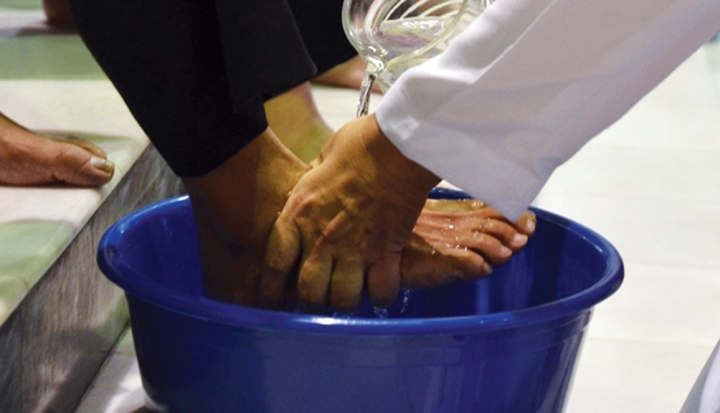Have you ever wondered why we don’t wash feet in church every Sunday? It’s something I think about every Holy Thursday, when at my parish the bowls and pitchers and towels come out after the gospel, the music begins, and there’s an awkward pause in the ritual: Is anyone going to do it this year? And then inevitably someone—usually a parent dragged by a small child—gets the action going. Before you know it, every bowl has a foot in it, and (almost) everyone takes a turn at washing and being washed.
The gospels of Matthew, Mark, and Luke all tell a similar story of the Last Supper, with Jesus blessing bread and wine and sharing them, commanding his friends to remember him in this way.
And every week that is more or less what we do. But on Holy Thursday night, we read the “other” institution of the Eucharist, from the Gospel of John: no bread, no wine, no food at all. Just feet—not at all appetizing—along with an apostolic show of resistance from Peter, to which we all can probably relate as we peel off our socks and hope that we remembered to clip our toenails.
But if it’s so important, the very core of following Jesus, why not do it every Sunday? Is it just impractical to wash feet? Or is it something about feet specifically? Why not hands? If Jesus just wanted to present an object lesson about serving one another, preparing the meal or waiting at table surely would have sufficed.
Then again, there is something about feet: They are the places on our bodies where we most often touch the ground from which we were taken and to which we will return. They are the precarious perches that bear all of our weight, performing miraculous feats of balance, but sometimes failing equally spectacularly. They even preserve the record of our lives, starting out newborn soft and clean and usually ending up so gnarly, calloused, and beat up that no amount of buffing or care can erase the wear and tear they suffered.
Maybe that’s why, among other things, Peter gets so incensed at Jesus’ behavior: It’s bad enough that Jesus is behaving like a slave, but washing feet is just too much to tolerate. “You will never wash my feet,” says Peter. “Unless I wash you, you have no share with me,” comes the harsh reply (John 13:8).
It’s not just a question of feet, but of exposing feet, of being washed as well as washing. Jesus isn’t talking here about the kind of service where someone with a lot of something gives it to someone who doesn’t have enough; there are no haves and have-nots at the Lord’s table. It’s about a different kind of relationship altogether, one in which everyone recognizes that we all have dirty feet and we need each other to be made clean.
Maybe that’s why weekly foot washing never really caught on. It’s a little hard to expose week after week that our feet keep getting dirty and that we need to keep coming back to wash and be washed. With that kind of nakedness, it would be hard for some of us to lord it over others. The emperor would have no shoes.
“Now the Son of Man has been glorified, and God has been glorified in him,” says Jesus of what he has done (John 13:31). When we wash and are washed, we celebrate the heart of what we do every Sunday over bread and wine. The good news is that God welcomes us, dirty feet and all, to sit and eat at the family table. The only etiquette required is that we must wash and allow ourselves to be washed, caring for each other—and the world—as we would a family member.
We don’t wash feet every Sunday, but at least on this one night, we get our once-yearly chance to practice in ritual the shape of Christian life. Do we dare take off our shoes and socks, to come with dirty feet and be washed? Do we dare to kneel down and wash another person’s dirty feet? Or, to ask it another way: Will we let God be glorified in us, as God was glorified in Jesus?
This article appeared in the April 2014 issue of U.S. Catholic (Vol. 79, No. 4, page 8).
Image: Flickr photo cc by Johnragai














Add comment